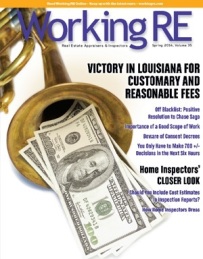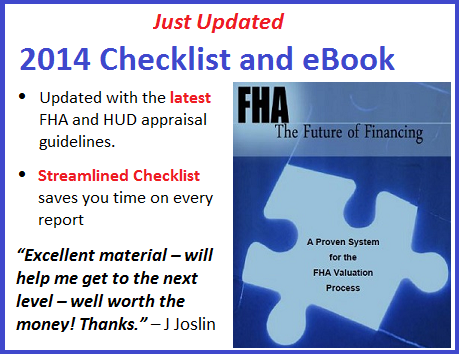 |
>> See Past News Editions >> Click to Print > Expert’s Guide to Defensible Workfile “Bulletproof” your workfile, protect your license and your livelihood with this expert help. Make your time count: learn quick tips from an expert on how to produce highly defensible reports that keep you safe and raise the quality of your product. Click now. > Do You Do FHA Appraisals? |
Editor’s Note: Blessings to you and yours this holiday season.
Collateral Underwriter and Chicken Little
By Rich Heyn, SRA and Dawn Molitor-Gennrich, SRA
“My, oh, my, the sky is falling. I must run and tell the others,” said Chicken Little.
Apparently, a recent announcement by Fannie Mae has some appraisers thinking like Chicken Little. In October of this year Fannie Mae announced the release of Collateral Underwriter, a “proprietary appraisal risk assessment application developed by Fannie Mae to support proactive management of appraisal quality.” Essentially, Collateral Underwriter (CU) is a software tool that will allow lenders to evaluate appraisal reports using the same analytics used by Fannie Mae. CU will make its debut on January 26, 2015.
When the Uniform Appraisal Dataset (UAD) and Uniform Collateral Data Portal (UCDP) were instituted in late 2011, Fannie Mae began aggregating data from millions of appraisal reports processed through the UCDP. As a result of this initiative, the data is harvested and used to fuel analytical tools that can “score” a report and assign a risk factor.
Initially, the UCDP was “rules-based” in that it simply compared the report data against a set of rules and identified omissions and inconsistencies within the appraisal report. Over time and as the amount of data grew, Fannie Mae was able to develop a “model-based” analysis that evaluates the reports for, in their words, “data integrity, comparable selection, adjustments, and reconciliation.”
So there is no really big news here so far. Fannie Mae is doing just what they said they intended to do when they developed the UAD and UCDP- use technology to improve the quality of appraisal reports submitted to them. The big news here is that Fannie Mae will be sharing this technology with their lender clients and their agents, allowing them to submit reports to CU for evaluation and risk scoring. Appraisers will not be given access to CU.
(story continues below)

(story continues)
So you are probably wondering what this all means to you. The short answer is that it’s simply too early to tell, and that anything you hear other than what’s been published by Fannie Mae is speculation. However, we do know that lenders and their agents will be processing reports through CU prior to submission to Fannie Mae. If CU flags issues in a report, it seems likely that, at least in some cases, the appraiser will be contacted and asked to resolve the flagged items. However, that’s not a given. Other than 21 defined “fatal edits,” CU messages do not have to “pass” before Fannie Mae will purchase the loan. As stated by Fannie Mae, CU messages are designed to “simply highlight aspects of the appraisal that may require further attention.” That’s Fannie Mae’s way of saying, “lender- please read the appraisal report in those sections flagged to ensure comments or explanations are provided by the appraiser per the standards in our Selling Guide.”
There is a substantial amount of information about CU on Fannie Mae’s website, which we would encourage you to review and get the right information rather than relying on hearsay or speculation.
As you go through, keep in mind this information is written for lenders and that there is quite a bit of verbiage that does not apply to appraisers. There are also two on-demand e-learning courses that we highly encourage you to take.
While CU does have the potential of generating increased callbacks and “stips,” especially when first introduced, these should decline over time. And yes, your data and adjustments will be compared against what other appraisers (including you) used on prior reports. Fannie plans to initially focus on adjustments and material differences for key property characteristics and ratings for Quality, Condition, View and Location. Focus on what you need to do to provide credible and compliant appraisal reports that demonstrate logic, reasoning and evidence for your opinions and conclusions.
(story continues below)

(story continues)
Here are six things you can consider doing between now and January 26th:
1. Review and stick to appraisal fundamentals; brush up on your techniques.
2. Derive supportable adjustments from market data rather than using a list handed down to you from your grandfather who was an appraiser 50 years ago.
3. Develop and explain how you derived your GLA adjustments; don’t use the same $35/sf adjustment for your $50,000 properties and your $500,000 properties, unless you can truly support it with market evidence. Yes, they check all of your reports for patterns like that.
4. Double check your subject and comparable data and if it differs from MLS, public records data, or any other data source on which you relied, provide an explanation from your research.
5. Be consistent between reports with your ratings for quality and condition. If you have good reason to change a rating from one report to another, document it properly in the appraisal report. If you have reason to believe your information is better and that your opinion may differ from that of other appraisers be prepared to support it.
6. Be cognizant of your adjustment factors and include support for your opinions and conclusions as they might differ from other appraisers or an automated valuation model.
Finally, don’t worry about things that may not happen. Fear-mongering and doomsday predictions seem to accompany many major announcements from Fannie Mae. Appraisers have been predicting the demise of the profession and dire consequences for all of the years that we have been appraising. If you are doing work that is credible you’ll live through this event as you have the others.
As an object lesson, do you remember what happened to Chicken Little and her doomsayer friends? They got eaten by the Fox.
> Find Directory of Best AMCs to Work With
Hot: On-Demand Webinar
Fighting Appraisal Board Complaints: Expert’s Advice
Great presentation! I hope that I will never have need or use for the information, but I feel better prepared in the event that I ever do. Thanks!
– Gary Hartmann
Fighting Appraisal Board Complaints: Expert’s Advice
Bob Keith, MAA, IFA, Former Executive Director and Compliance Coordinator for the Oregon Appraisal Board, gives you an expert’s insight into the complaint process, showing you how to avoid the most common mistakes appraisers make when dealing with their state board. Save yourself the pain with this insider help. Learn what steps to take to protect yourself before, during and after a complaint surfaces and what is and isn’t in your own best interests. Keith takes you through a step-by-step process on how to interact with your state board to achieve the best results possible. Put an expert on your side. Read More.
Watch on Demand $39
(FREE to OREP Members/ Affiliates / WRE Subscribers. Email isaac@orep.org for your invitation.)
About the Author
Isaac Peck is the Associate Editor of Working RE magazine and the Director of Marketing at OREP.org, a leading provider of E&O insurance for appraisers, inspectors and other real estate professionals in 49 states. He received his Master’s Degree in Accounting at San Diego State University. He can be contacted at Isaac@orep.org or (888) 347-5273.
>Click to Print
>Subscribe to Working RE Newsletters
Send your story submission/idea to the Editor: dbrauner@orep.org

